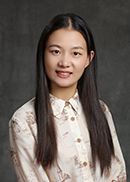
Yuqun Cai
Address: 2nd Floor, Medical Research Building, No. 131 Dong'an Road, Xuhui District, Shanghai
Email:caiyuqun@fudan.edu.cn
Dr.Yuqun Cai graduated with a bachelor's degree in biological sciences from the School of Life Sciences, Nanchang University in 2007, and graduated with a Ph.D. from the Neural Stem Cell and Neurodevelopment Group of the Institute of Brain Science, Fudan University in 2013, and was awarded the "Shanghai Excellent Graduate". From 2013 to 2015, she was engaged in postdoctoral research on resting and activation of adult neural stem cells in the School of Life Sciences, Tongji University. From 2015 to 2019, she worked as an assistant researcher at the Research Institute of Brain Science, Fudan University. She has obtained 1 post-doctoral fund and 1 National Natural Science Foundation of China Youth Project. She has published more than 10 professional papers in Stem Cells, JCR, Neurosci. Bull., Nat Neurosci, EMBO reports and other journals. She joined the Institute of Brain Science Transformation of Fudan University in September 2020 as administrative personnel.
Publications:
1. Wang, Y., Lu, Z., Zhang, Y.,Cai, Y., Yun, D., Tang, T., Cai, Z., Wang, C., Zhang, Y., Fang, F., et al. (2020). Transcription Factor 4 Safeguards Hippocampal Dentate Gyrus Development by Regulating Neural Progenitor Migration. Cerebral cortex 30, 3102-3115.
2. Cai, Y.#, and Yang, Z. (2019). Adult Neural Stem Cells: Constant Extension from Embryonic Ancestors. Neuroscience bulletin. (#corresponding author)
Zhu, K., Shan, Z., Chen, X.,Cai, Y., Cui, L., Yao, W., Wang, Z., Shi, P., Tian, C., Lou, J., et al.(2017). Allosteric auto-inhibition and activation of the Nedd4 family E3 ligase Itch. EMBO reports 18, 1618-1630
3. Cai, Y., She, K., and Wang, C. (2015). Transient Sp8+ handlebar-like interneuron structure traversing the corpus callosum during the second postnatal week. Neuroreport 26, 216-222.
4. Cai, Y.*, Zhang, Y.*, Shen, Q., Rubenstein, J.L., and Yang, Z. (2013b). A subpopulation of individual neural progenitors in the mammalian dorsal pallium generates both projection neurons and interneurons in vitro. Stem cells 31, 1193-1201. (*co-first author)
5. Cai, Y.*, Zhang, Q.*, Wang, C., Zhang, Y., Ma, T., Zhou, X., Tian, M., Rubenstein, J.L., and Yang, Z. (2013a). Nuclear receptor COUP-TFII-expressing neocortical interneurons are derived from the medial and lateral/caudal ganglionic eminence and define specific subsets of mature interneurons. The Journal of comparative neurology521, 479-497.(*co-first author)
6. Ma, T., Wang, C., Wang, L., Zhou, X., Tian, M., Zhang, Q., Zhang, Y., Li, J., Liu, Z.,Cai, Y., et al.(2013). Subcortical origins of human and monkey neocortical interneurons.Nature neuroscience16, 1588-1597.
7. Ma, T., Zhang, Q.,Cai, Y., You, Y., Rubenstein, J.L., and Yang, Z. (2012). A subpopulation of dorsal lateral/caudal ganglionic eminence-derived neocortical interneurons expresses the transcription factor Sp8.Cerebral cortex (New York, NY : 1991) 22, 2120-2130.
8. Wei, B., Nie, Y., Li, X., Wang, C., Ma, T., Huang, Z., Tian, M., Sun, C.,Cai, Y., You, Y., et al.(2011). Emx1-expressing neural stem cells in the subventricular zone give rise to new interneurons in the ischemic injured striatum. The European journal of neuroscience 33, 819-830.
9. Wang, C., Zhang, M., Sun, C.,Cai, Y., You, Y., Huang, L., and Liu, F. (2011). Sustained increase in adult neurogenesis in the rat hippocampal dentate gyrus after transient brain ischemia. Neuroscience letters 488, 70-75.